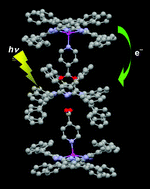Charge separation in metallomacrocycle complexes linked with electron acceptors by axial coordination
Abstract
A simple but elegant way to obtain linked donor–acceptor entities involving metallomacrocycle complexes with fixed distance and orientation is the use of coordination of axial

- This article is part of the themed collection: Supramolecular photochemistry

 Please wait while we load your content...
Please wait while we load your content...